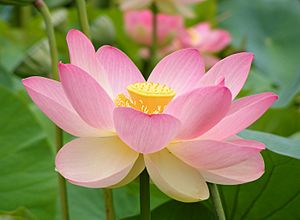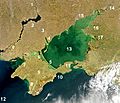Sea of Azov facts for kids
Quick facts for kids Sea of Azov |
|
|---|---|

Sea of Azov shoreline at Novaya Yalta, Donetsk Oblast
|
|
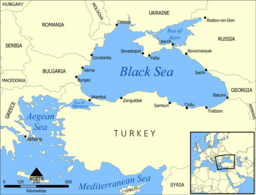 |
|
| Coordinates | 46°N 37°E / 46°N 37°E |
| Type | Sea |
| Primary inflows | Don and Kuban |
| Max. length | 360 km (220 mi) |
| Max. width | 180 km (110 mi) |
| Surface area | 39,000 km2 (15,000 sq mi) |
| Average depth | 7 metres (23 ft) |
| Max. depth | 14 m (46 ft) |
| Water volume | 290 km3 (240×106 acre⋅ft) |
The Sea of Azov is a shallow sea in Eastern Europe. It is connected to the Black Sea by a narrow passage called the Strait of Kerch. This strait is only about 4 kilometers (2.5 miles) wide. Some people think of the Sea of Azov as a northern part of the Black Sea.
The sea is bordered by Ukraine in the northwest and Russia in the southeast. Two big rivers, the Don and the Kuban River, flow into it. Water from the Sea of Azov constantly flows out into the Black Sea.
The Sea of Azov is the shallowest sea in the world. Its depth changes from about 0.9 meters (3 feet) to 14 meters (46 feet). Many rivers bring sand, mud, and shells into the sea. These materials create many bays, lagoons (called limans), and narrow strips of land (called spits). Because of these deposits, the sea bottom is mostly smooth and flat. The water gets deeper slowly as you move toward the middle of the sea.
The river water also makes the sea less salty. It brings in a lot of living things, like green algae, which can change the water's color. There is also a lot of tiny plant and animal life called plankton. This helps many fish to grow, making the sea a great place for fishing. The shores and spits are low and have many plants and bird colonies.
Contents
Climate and Weather in the Sea of Azov
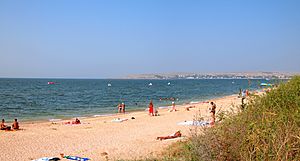
The Sea of Azov is small and almost completely surrounded by land. This means it has a continental climate. Winters are cold, and summers are hot and dry.
Winter Weather and Ice Formation
In autumn and winter, cold, dry air comes from Siberia. This air is brought by something called the Siberian High. Winds usually blow at 4–7 meters per second (9–16 mph). Sometimes, they can reach 15 meters per second (34 mph). These strong winds can make winter temperatures drop very low. Usually, it's about -1 to -5 °C (30–23 °F), but it can fall below -30 °C (-22 °F).
The sea's shallow depth and low saltiness mean it can freeze in winter. Ice can form from late December to mid-March. This ice can be 7 kilometers (4.3 miles) wide in the north. It can be 1.5 kilometers (0.9 miles) wide in the south. In 2012, several ships got stuck in the ice. The ice can be 30–40 centimeters (12–16 inches) thick in most areas. In Taganrog Bay, it can be 60–80 centimeters (24–31 inches) thick. The ice is often not stable and can pile up several meters high. Before icebreaker ships were used, boats could not travel in winter.
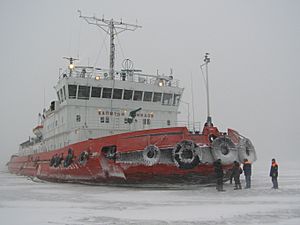
Summer Temperatures and Winds
In summer, the average temperature is 23–25 °C (73–77 °F). It can reach about 40 °C (104 °F). Winds are lighter in summer, usually 3–5 meters per second (7–11 mph). The sea surface is usually a bit warmer than the air. Because the sea is shallow, the water temperature does not change much with depth. It usually drops by only about 1 °C (1.8 °F).
Rainfall and Water Movement
The amount of rain and snow (called precipitation) varies. It is between 312 and 528 mm (12–21 inches) per year. There is 1.5 to 2 times more precipitation in summer than in winter.
Winds often cause storms. Waves can reach 6 meters (20 feet) high in Taganrog Bay. Near the southern shores, they are 2–4 meters (7–13 feet) high. In the Kerch Strait, they are about 1 meter (3 feet) high. In the open sea, waves are usually 1–2 meters (3–7 feet) high. Sometimes, they can reach 3 meters (10 feet). Winds also create "seiches." These are standing waves that can be 20–50 cm (8–20 inches) high. They can last from minutes to hours.
Winds also create water currents. The main current is a counterclockwise swirl. This is caused by winds from the west and southwest. These currents are usually slow, less than 10 cm/s (4 inches/s). But they can reach 60–70 cm/s (24–28 inches/s) with strong winds. In the bays, river water mostly controls the flow. It moves away from the shore. In the Kerch Strait, water usually flows towards the Black Sea. This is because of northern winds and river water flowing in. Its average speed is 10–20 cm/s (4–8 inches/s). It can reach 30–40 cm (12–16 inches) in the narrowest parts. Tides can vary but can reach 5.5 meters (18 feet).
Sea Life: Plants and Animals
Historically, the Sea of Azov had a lot of different marine life. There were over 80 types of fish and 300 types of small animals without backbones. Fishing has been a very important activity here for a long time. In recent years, about 300,000 tons of fish were caught each year. About half of these were valuable fish like sturgeon, pike-perch, and bream.
The sea was very productive because many rivers brought nutrients. The water was not very salty, and it was warm due to being shallow. This helped plants and animals grow for a long time each year. However, the number and types of species have gone down. This is due to dams reducing river flow and too much fishing. Also, large farms growing cotton use a lot of water and cause pollution. Fish catches have dropped quickly, and some fisheries, like for anchovy, have almost disappeared.
Tiny Life: Plankton and Benthos
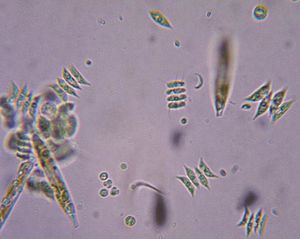
Because the Sea of Azov is shallow, its water life is like a lagoon. The tiny plants and animals (plankton) are similar in the open sea and near the shores. The water is not very clear, so plants on the bottom do not grow well. Most algae are plankton, floating in the water. The sea has a lot of organic matter and long periods when algae grow quickly.
The saltiness of the water changes a lot. It is low in big bays and higher in the open sea, especially near the Kerch Strait. So, plankton species are not spread evenly. Many species come from the saltier Black Sea. But most cannot live in the changing saltiness of the Sea of Azov. Only species that can handle different salt levels (euryhaline species) survive.
About 600 types of planktonic algae live in the Sea of Azov. Most are diatoms and green algae. Blue-green algae are also common. Green algae are mostly why the sea looks green in satellite pictures.
For tiny animals (zooplankton), the fresh waters of Taganrog Bay have cladocera, copepoda, and rotifers. The western part of the sea is saltier. It has different types of Acartia clausi and other small animals.
Benthos species live mostly on the sea bottom. These include worms, crustaceans (like crabs), and mollusks (like clams). Mollusks make up most of the animal life on the Sea of Azov bottom.
Fish Species in the Sea of Azov

There are 183 types of fish in the Sea of Azov region. Among them, 50 species are rare, and 19 are in danger of disappearing. The sturgeon Acipenser nudiventris might even be gone from the area.
The freshwater Taganrog Bay has fewer fish species. It has 55 types of fish. Three of these are rare, and 6 are endangered.
Plants on the Shores
The shores of the Sea of Azov have many estuaries (where rivers meet the sea) and marshes. These areas are full of reeds, sedges, and Typha plants. Plants that grow underwater include Charales, pond weed, and water lilies. The sacred lotus is also common. There are many different plant species. For example, the Belosaraysk and Berdyansk spits each have over 200 types of plants. Some spits, like Beglitsk, Belosaraysk, Krivaya, and Berdyansk Spits, are protected as national nature reserves.
Animals on the Shores

The estuaries and spits are home to many birds, especially water birds. You can see wild geese, ducks, and seagulls. Large groups of cormorants and pelicans are common. Swans, herons, sandpipers, and many birds of prey are also often seen.
Mammals living here include foxes, wild cats, hares, hedgehogs, weasels, martens, and wild boar. Muskrats were brought to the area in the early 1900s. People hunt them for their fur.
Animals Visiting and Invading the Sea
Some fish, like anchovy, garfish, and Black Sea whiting, come to the Sea of Azov from the Black Sea to lay their eggs. This happened a lot in 1975–77 when the southern Sea of Azov was unusually salty. More species like bluefish and turbot were seen then. Unlike Black Sea plankton, which struggles with low saltiness, Black Sea fish and invertebrates adapt well. They are often stronger than the native species and can survive the winter in the Sea of Azov.
Balanus improvisus was the first bottom-dwelling species to spread from the Black Sea. This happened in the early 1900s. Now, there can be 7 kg (15 lbs) of them per square meter. Since 1956, the Rapana venosa has been seen in the Sea of Azov. But it cannot handle the low saltiness, so it stays near the Kerch Strait. Several Sea of Azov mollusks, like shipworm and soft-shell clam, came from the Black Sea. Another invading species is the Dutch crab Rhithropanopeus harrisii. It lives in both salty and fresh parts of the sea.
In the past, three types of dolphins often visited the Sea of Azov from the Black Sea. These were the short-beaked common dolphin, common bottlenose dolphin, and harbour porpoise. One type of harbour porpoise, Phocoena phocoena relicta, used to live in the Sea of Azov. It was even called the "Azov dolphin." Today, dolphins are rarely seen in the Sea of Azov. This is because the sea is getting shallower, there are more boats, more pollution, and fewer fish.
Images for kids
-
Capture of Azov 1696, a painting by Robert Ker Porter.
-
A satellite image of the Sea of Azov. You can clearly see how shallow the Sea of Azov is compared to the deeper Black Sea. Numbers point to: 1. Dnieper River, 2. Kakhovka Reservoir, 3. Molochna River, 4. Molochny Liman, 5. Arabat Spit, 6. Sivash lagoon system, 7. Karkinit Bay, 8. Kalamitsky Bay, 9. Crimea, 10. Fedosiysky Bay, 11. Strait of Kerch, 12. Black Sea, 13. Sea of Azov, 14. Don River (Russia), 15. Taganrog Bay, 16. Yeysk Liman, 17. Beisug Liman
See also
 In Spanish: Mar de Azov para niños
In Spanish: Mar de Azov para niños


